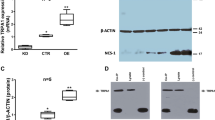Abstract
1. Aminoalkylindoles, typified by WIN 55212-2, bind to G protein-coupled cannabinoid receptors in brain. Although cannabinoids inhibit adenylyl cyclase in NG108-15 neuroblastoma × glioma hybrid cells, cannabinoid receptor binding in these cells has not been described previously. This study compares pharamcological characteristics of [3H]WIN 55212-2 binding sites in rat cerebellar membranes and in NG108-15 membranes.
2. Although the K D of specifid [3H]WIN 55212-2 binding was similar in brain and NG108-15 membranes, the B max was 10 times lower in NG108-15 than in cerebellar membranes. In both brain and NG108-15 membranes, aminoalkylindole analogues were relatively potent in displacing [3H]WIN 55212-2 binding.However, IC50 values for more traditional cannabinoids were significantly higher in NG108-15 membranes than in brain, e.g., the K i values for CP55,940 were1.2nM in brain and >5000nM in NG108-15 membranes. Moreover, sodium and GTP-γ-S decreased [3H]WIN 55212-2 binding in brain but not in NG108-15membranes.
3. These data suggest that WIN 55212-2 does not label traditional cannabinoid receptors in NG108-15 cells and that these novel aminoalkylindolebinding sites are not coupled to G proteins.
Similar content being viewed by others
REFERENCES
Bradford, M. M. (1976). A rapid and sensitive method for the quantification of microgram quantities of protein utilizing the principle of protein-dye binding. Anal. Biochem. 72:248–254.
Cheng, Y.-C., and Prusoff, W. H. (1973). Relationship between the inhibition constant (K i) and the concentration of inhibitor that causes 50 per cent inhibition (I50) of an enzymatic reaction. Biochem. Pharmacol. 22:3099–4002.
Childers, S. R. (1991). Opioid receptor-coupled second messengers. Life Sci. 48:1991–2003.
Childers, S. R., Sexton, T., and Roy, M. B. (1994). Effects of anandamide on cannabinoid receptors in rat brain membranes. Biochem. Pharmacol. 47:711–715.
Chu, D. C. M., Albin, R. L., Young, A. B., and Penney, J. B. (1990). Distribution and kinetics of GABAB binding sites in rat central nervous system: A quantitative autoradiographic study. Neuroscience 34:341–357.
Compton, D., Johnson, M. R., Melvin, L., and Martin, B. R. (1992). Pharmacological profile of a series of bicyclic cannabinoid analogues: Classification as cannabimimetic agents. J. Pharmacol. Exp. Ther. 260:201–209.
Creese, I., and Snyder, S. H. (1975). Receptor binding and pharmacological activity of opiates in the guinea pig intestine. J. Pharmacol. Exp. Ther. 194:205–219.
Devane, W. A., Dysarz, F. A. I., Johnson, M. R., Melvin, L. S., and Howlett, A. C. (1988). Determination and characterization of a cannabinoid receptor in rat brain. Mol. Pharmacol. 34:605–613.
Fan, F., Tao, Q., Abood, M. E., and Martin, B. R. (1996). Cannabinoid receptor down-regulation without alteration of the inhibitory effect of CP 55,940 on adenylyl cyclase in the cerebellum of CP 55,940-tolerant mice. Brain Res. 706:13–20.
Gaoni, Y., and Mechoulam, R. (1964). Isolation, structure, and partial synthesis of an active constituent of hashish. J. Am. Chem. Sco. 86:1646–1647.
Herkenham, M., Lynn, A. B., Little, M. D., Johnson, M. R., Melvin, L. S., De Costa, B. R., and Rice, K. C. (1990). Cannabinoid receptor localization in brain. Proc. Natl. Acad. Sci. USA 87:1932–1936.
Herkenham, M., Lynn, A. B., Johnson, M. R., Melvin, L. S., de Costa, B. R., and Rice, K. C. (1991). Characterization and localization of cannabinoid receptors in rat brain: A quantitative in vitro autoradiographic study. J. Neurosci. 11:563–583.
Howlett, A. C. (1984). Inhibition of neuroblastoma adenylyl cyclase by cannabinoid and nantradol compounds. Life Sci. 35:1803–1810.
Howlett, A. C. (1985). Cannabinoid inhibition of adenylate cyclase: Biochemistry of the response in Neuroblastoma cell membranes. Mol. Pharmacol. 27:429–436.
Howlett, A. C., and Fleming, R. M. (1984). Cannabinoid inhibition of adenylate cyclase: Pharmacology of the response in neuroblastoma cell membranes. Mol. Pharmacol. 26:532–538.
Howlett, A. C., Qualy, J. M., and Khachatrian, L. L. (1986). Involvement of Gi in the inhibition of adenylate cyclase by cannabimimetic drugs. Mol. Pharmacol. 29:307–313.
Howlett, A. C., Johnson, M. R., Melvin, L. S., and Milne, G. M. (1988). Nonclassical cannabinoid analgesics inhibit adenylate cyclase: Development of a cannabinoid receptor model. Mol. Pharmacol. 33:297–302.
Jansen, E. M., Haycock, D. A., Ward, S. J., and Seybold, V. S. (1992). Distribution of cannabinoid receptors in rat brain determined with aminoalkylindoles. Brain Res. 575:93–102.
Kenakin, T. (1993). Efficacy. In Pharmacologic Analysis of Drug-Receptor Interaction, Raven, New York, pp. 249–277.
Kuster, J., Stevenson, J., Ward, S., D'Ambra, T., and Haycock, D. (1993). Aminoalkylindole binding in rat cerebellum: Selective displacement by natural and synthetic cannabinoids. J. Pharmacol. Exp. Ther. 264:1352–1363.
Pacheco, M., Childers, S. R., Arnold, R., Casiano, F., and Ward, S. J. (1991). Aminoalkylindoles: Actions on specific G-proetin-linked receptors. J. Pharmacol. Exp. Ther. 257:170–183.
Pacheco, M., Ward, S. J., and Childers, S. R. (1993). Identification of cannabinoid receptors in cultures of rat cerebellar granule cells. Brain Res. 603:102–110.
Selley, D. E., Breivogel, C. S., and Childers, S. R. (1993). Modification of opioid receptor-G-protein function by low pH pretreatment of membranes from NG108-15 cells: Increase in opioid agonist efficacy by decreased inactivation of G-proteins. Mol. Pharmacol. 44:731–741.
Sim, L. J., Selley, D. E., and Childers, S. R. (1995). In vitro autoradiography of receptor-activated G-proteins in rat brain by agonist-stimulated guanylyl 5′-[γ-[35S]thio]-triphosphate binding. Proc. Natl. Acad. Sci. USA 92:7242–7246.
Sim, L. J., Selley, D. E., Xiao, R., and Childers, S. R. (1996). Differences in G-protein activation by mu and delta opioid, and cannabinoid, receptors in rat striatum. Eur. J. Pharmacol. 307:95–107.
Ward, S. J., Baizman, E., Bell, M., Childers, S., D'Ambra, T., Eissenstat, M., Estep, K., Haycock, D., Howlett, A., Luttinger, D., et al. (1990). Aminoalkylindoles (AAIs): A new route to the cannabinoid receptor? NIDA Res. Monogr. 105:425–426.
Author information
Authors and Affiliations
Rights and permissions
About this article
Cite this article
Stark, S., Pacheco, M.A. & Childers, S.R. Binding of Aminoalkylindoles to Noncannabinoid Binding Sites in NG108-15 Cells. Cell Mol Neurobiol 17, 483–493 (1997). https://doi.org/10.1023/A:1026306804802
Issue Date:
DOI: https://doi.org/10.1023/A:1026306804802




